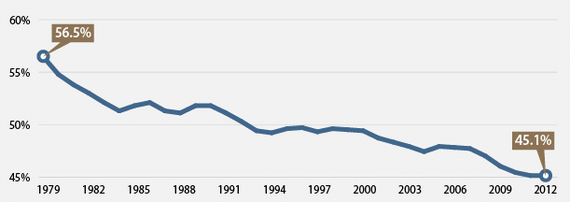The slogan “We are the 99%,” popularized by Occupy Wall Street protesters, refers to income inequality and wealth distribution in the U.S. between the wealthiest 1% and the rest of the population. When it comes to “making it,” many young persons today feel anxious and vulnerable.
Sayonara, middle class?
The 99% is not about the inability of some to afford the finer things in life. Rather, it’s about stagnant incomes and the rising cost of being in the middle class and of maintaining a middle-class standard of living. In his 2015 State of the Union speech, President Obama called income inequality a defining issue of our time. Pope Francis has sharply criticized growing economic inequality and IMF Managing Director Christine Lagarde warns that the income gap risks creating “an economy of exclusion, and a wasteland of discarded potential.” Aside from a certain amount of squabbling, it’s no longer possible to deny that the middle class is in trouble.

Source: Center for American Progress
The group that’s historically fallen in the earnings middle, living a life of neither luxury nor poverty, is shrinking. A report by the Center for American Progress (2014) shows that in 1979, 56% of American households had incomes that qualified them as middle class (defined as working-age households with incomes between 0.5 and 1.5 times the median national income). In 2012, the share of middle class families had fallen to 45%, indicating that the American households have become more concentrated at the top and bottom of the earnings ladder. Like an orange, the middle class is being squeezed.
 Economists at Standard & Poors (2014) conclude that the level of income inequality in the U.S. is dampening demand for goods and services, resulting in the weakest growth in 50 years. Because the affluent tend to save more of what they earn rather than spend it, as more and more of the nation’s income goes to people at the top income brackets (see: You’ve got class!) there isn’t enough demand for goods and services to maintain strong growth, they say. If true, this could have a detrimental effect on future job opportunities, investment returns, and tax revenues. So, Gen NeXt, shall we kill all the bankers (before the lawyers)? Maybe not.
Economists at Standard & Poors (2014) conclude that the level of income inequality in the U.S. is dampening demand for goods and services, resulting in the weakest growth in 50 years. Because the affluent tend to save more of what they earn rather than spend it, as more and more of the nation’s income goes to people at the top income brackets (see: You’ve got class!) there isn’t enough demand for goods and services to maintain strong growth, they say. If true, this could have a detrimental effect on future job opportunities, investment returns, and tax revenues. So, Gen NeXt, shall we kill all the bankers (before the lawyers)? Maybe not.
Theory of relativity.
It is true that U.S. income inequality is at its highest level since the United States Census Bureau began tracking household income in 1967. What is not true, however, is that incomes stagnated for everyone but the upper middle class and the rich. The Congressional Budget Office (2011) examined income trends for the past three decades and found sizable gains for all income groups. Sure, the top 1 percent outdid everyone: from 1980 to 2011, their inflation-adjusted pretax incomes grew a spectacular 200 percent, almost a tripling. But for the poorest fifth of Americans, pretax incomes for these years rose nearly 50 percent. The wealthy ate most of the pie, but everyone got a bite.
Also, while paycheck stress is on everybody’s mind, you can’t factor out that your money is buying a higher quality of life. Social scientists tell us it is social equality, or “equality of respect,” that lies at the root of our worry about economic equality. They point to relative income—keeping up with the Joneses and staying ahead of the Smiths—as an important determinant of happiness. In this respect, the quality of lives across the income scale is becoming more similar, not less. Do you enjoy air conditioning and cable TV? Own a car? An iPhone? How about that wide, flat-screen TV and DVD player? As Einstein conjectured, all things are relative (including paychecks and cousins).
Don’t get left behind!
Rather than simply bash the “1 percent,” why not concentrate on developing a plan to secure (and maintain) your own place in the middle class? After all, no one is better equipped to succeed than you. Here are some tips:
- There is a 97–99 percent probability you will be middle class or below.
- Inequality rewards education, skills, and the ability to create value in the world. Instead of the 1 percent vs. 99 percent divide, this is the divide that matters most!
- Working hard is not enough. You must learn to think, anticipate, and adapt.
- Becoming “personal economics savvy” early will reduce anxiety.
- Take 100 percent responsibility for what happens in your life.
The world has changed for the middle class. Now the only guarantee that today’s worker can expect is that you put in a day’s work, you get a day’s pay—that’s it.
~ Arianna Huffington, author and columnist
Learn more about this, and other interesting topics, in the Young Person’s Guide to Wisdom, Power, and Life Success.
Image credit: “Young couple calculating their domestic bills” by wavebreakmediamicro, licensed from 123rf.com (2015).




















